Several good timelines have been made of vintage tokens on Bitcoin. Most of these tokens are Counterparty assets.
Here’s a guide on how to research Counterparty history, followed by my comments on specific tokens.
Disclaimer
I’m the creator of several vintage tokens. Most notable are OLGA and JPJA from 2014 and SALVATION from 2015. Some bias in inevitable but I do my best to stay objective.
Xchain
The only full block explorer for Counterparty is xchain.io. It’s a cornerstone of the Counterparty ecosystem, and I am infinitely grateful for all the efforts “J-Dog” has put into it. But even this gem of a website has a few quirks.
- Non-ASCII characters (i.e. non-English letters) are stripped from descriptions. For example, Xchain shows OLGA’s description as ‘One & Only’ while the correct one is ‘Моя Вечная One & Only’.
- The issuance timeline of an asset is difficult to make sense of. You need to manually compare all issuances to figure out what has changed and when.
- Images with no on-chain references have been added to some tokens, e.g. for Spells of Genesis cards. This is not necessarily wrong, just means that Xchain has its own interpretation outside Counterparty (and Bitcoin). If, or when, immutable on-chain proofs become an important property, the archeologist needs to manually scrutinize Xchain.
Counterparty Asset Timeline
To address these issues, I made a timeline tool. It looks at on-chain events only. You can view the source code on Github.
The default view is of platform milestones. I made it easy to add or edit conditions. Simply download the project from Github, unzip, and edit counterparty.html in a text editor. The conditions begin at around line 400.

For example, if you want to find the 2nd. 3rd, nth NFTs you simply remove break; (or better comment it out: //break;). Save and the open the html file in your browser.
In case you wonder, the second 1/1 NFT is FFLTEAMA – a fantasy football team by the great Joe Looney – about six weeks after OLGA.
To view the timeline of a specific asset, use the search box in the top right corner. A permanent URL is found at the bottom of the page.
The Database
In its core, Counterparty is a database. This DB is built from instructions embedded in Bitcoin transactions. You can rebuild your exact copy of the DB by running a Federated Node, which is a Bitcoin node with all the Counterparty components.
In case this is too much, I’ve shared the Counterparty DB as of November 2021 on Dropbox. It’s a 1.6 GB download but takes up 5.7 GB once uncompressed.
Exploring the Database
I use SQLite to explore the DB.
[TODO: Write Explainer]
Exceptional Projects From 2014
In October 2014 I copied all my blog posts about Counterparty into a pdf file – jpja.net/pdf/Value-of-XCP.pdf.
I included its sha256 hash in a bitcoin transaction, making the file immutable.
Beyond comments on my own JPJA and CPNEWS, full description of the JPBULL/JPBEAR bitcoin options experiment, and notes on JPGOLD which add context to OLGA, the pdf lists more than 10 projects which I found the most significant at the time.
Last year I also wrote a list of tokens from 2014 and 2015 which I believe deserve attention.
These are not necessarily all candidates for your timeline. E.g. LTBcoin and Folding Coins are really great projects from the era, but their token supplies are in the hundreds of millions. Therefore hardly collector tokens. And, of course, if your timeline focuses on art, then some otherwise worthy collectables may not fit your criteria.
Questionable Tokens
I’ve seen the following tokens added to timelines.
These tokens should be removed in my opinion. I don’t blame anyone for adding them before the full picture was known, but after I present the following facts, I urge archeologists to 1) update accordingly or 2) explain me why I am wrong.
TESTER
It has no description, no off-chain references either as far as I know. It’s only the 18th single unit asset. Still unlocked, therefore the potential token supply is unlimited. If these criteria have any significance, then add SONY instead.
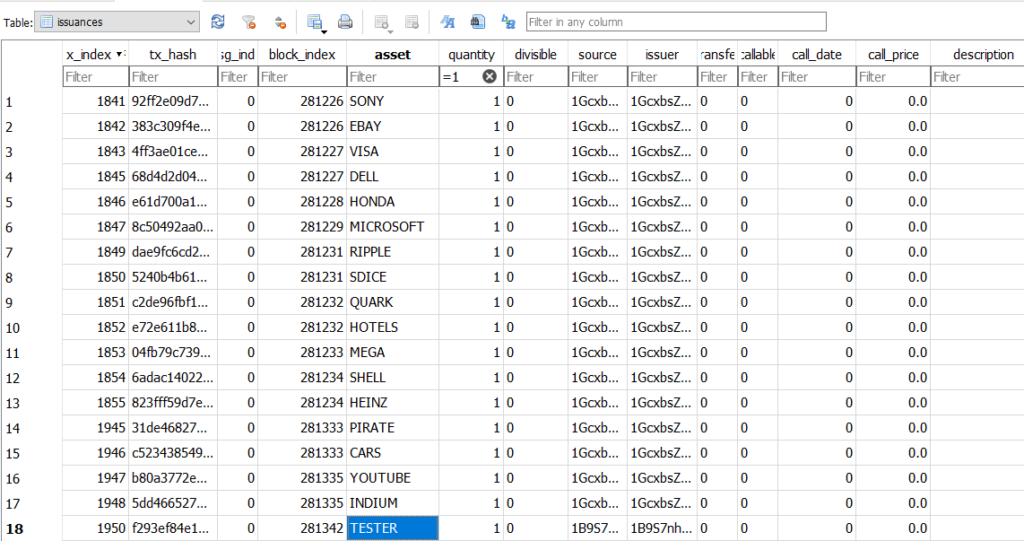
THING
It was issued with 1,000,000,000 tokens and no description. It too has no story until 2021 when all but one token was destroyed. Although THING is a very old asset, there are more than 100 even older indivisible assets that can do the same.
Inaccurate History
I will add more here as I encounter historical mistakes.
TEST
This is the first asset (at least if you exclude XCP). This makes it significant.

But claiming it’s a historic NFT is wrong, and I question whether its 2021 image deserves a spot on a historic timeline. It did not have any description prior to 2021. It did not symbolize anything either.
TEST does have a nice story though. It was used for testing the DEX where Etherscan founder Matt Tan was one of the parties. This is documented in the Bitcointalk forums.
UMBRELLA
This token from November 2014 was announced in a Bitcointalk post. The idea was to vote on design, then pre-sell UMBRELLA shares (tokens) which finally could be exchanged 1:1 for a real Bitcoin umbrella. The creator, Paul Schmitzer, told the full story in a 2021 Twitter thread. It is perfectly truthful as far as I can tell. He is open about the pre-sale never taking place. I admire him for his honesty.
I’m a fan of the idea too. It’s not too unlike JPJA, where tokens enable a second hand market for those who otherwise would have had their funds locked. Of course, as a proof-of-concept, but I image this can really add value to pre-buyers of cars and condos or investors in small businesses.
Where I do see a problem is when some (not Paul) forget to mention that the umbrellas never were produced. In fact, no token moved before 2021.
That said, better late than never. It has recently gained an energetic community. I think the Bitcoin umbrellas even are soon to be delivered. It definitively stands out as a creative pioneering idea, and sure is a collectable.
I also need to mention that other tokens may have been redeemable for physical products even earlier in 2014. SEBUH promised to ship out mining hardware already in June of that year. I think Digital Tangible had tokens promising physical delivery of gold. I leave it to archeologists to investigate this further.
Overlooked NFTs
MICE (3 indivisible, unlocked)
Already in April 2014 three tokens with name MICE and description “<:3_)~ squeak!” made their way into the Counterparty database. They’ve been hiding ever since, not to be seen even on the block explorer. The Xchain description is blank, most likely because J-Dog is afraid of html tags. You can view it on my timeline only.
FORMICACOIN (1000 divisible, locked)
On 2014-07-29 an image link was added. The url is still valid and shows a tiny ant. This is likely the first token linked to an image on Counterparty.
BOOKBAG (2000 indivisible, locked)
On 2014-08-06 Michael G Zigler Jr. tokenized his book, inspired by JPJA. The book even has a defined economic model. The entire book is preserved on Wayback Machine.
My Vintage Tokens
Here’s a summary of my tokens. I’m not saying all of them deserve a spot on your timeline, but please read through and decide for yourself.
OLGA (2014-06-12)

This is the first 1/1 locked token which technically makes it the first NFT. The title carries a symbolic meaning, and I’m proud to be the first ever to have expressed love this way. I later carved our image on the blockchain via a bitcoin transaction. The idea was that since blockchain is an eternal medium (even more so than the bedrock early humans used for carving petroglyphs) our token of love will last forever! Little did I know it would be discovered seven years later and become one of the most famous NFTs.
JPJA (2014-06-22)
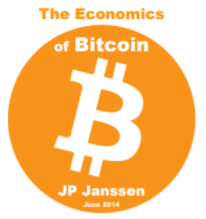
This can be considered a Book NFT and a DeFi contract. It was perhaps the first ever of both. I wanted to show that
“[B]itcoin is more than just a payment system. It is a financial platform of endless opportunities.”
The experiment was completed in December 2014 when the holders of JPJA received a dividend on a pre-determined date based on the book’s tip revenues.
As for any other book, the image representation of JPJA is the book cover. The original file is preserved by Wayback Machine.
JPBULL / JPBEAR (2014-09-05)
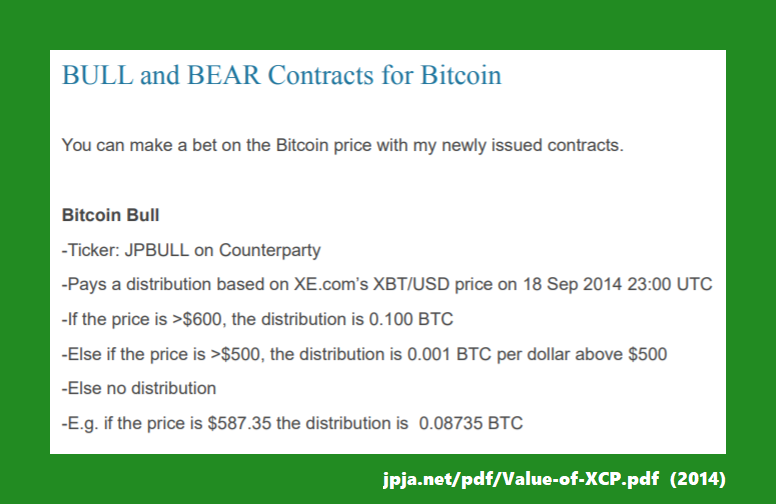
Perhaps the first ever tokenized Bitcoin options. This was a small scale experiment where I auctioned off put and call options on the Bitcoin price. At expiry the bitcoin price was below $500 and the JPBEAR holders received their payout. This showed how the blockchain could be used to make completely transparent and verifiable financial instruments.
The entire experiment is documented and timestamped.
I recently made image representations of these for Xchain. To stay historically correct these are the relevant paragraphs cut out from the original pdf (with only a colored frame added).
CPNEWS (2014-09-15)
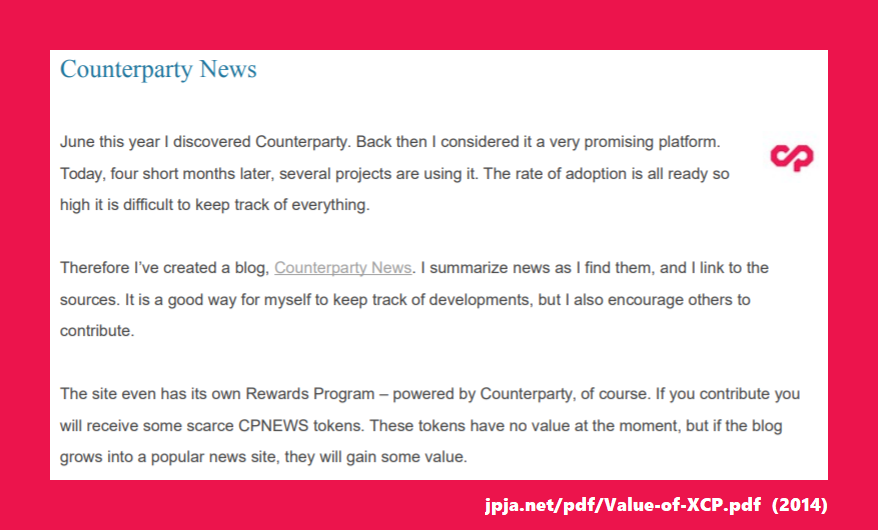
This was a Counterparty news website. The token was meant to show how multiple individuals can cooperate on a startup without any funding. Anyone who shares the vision, have some spare time and willing to do some work, can participate. The token guarantees transparent payouts, makes enforcement binary (either all or none get paid fairly) and enables a second hand DEX market.
Unfortunately I was not able to attract participants and the project got shut down after a few months. On the bright side, thanks to Counterparty News, several of the earliest Counterparty projects are documented.
Like with JPBULL/JPBEAR, the image on Xchain is a cutout from the original pdf.
SALVATION (2015-08-04)
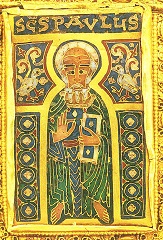
Issued anonymously, salvation was promised to a few prominent members of the Counterparty community. I enjoyed creating an ultra scarce (supply locked at seven) mystical token which was even discussed twice at the Bitcoin Uncensored show.
XCPCARDS.com (2015-11-24)
This set of four cards – CHURCHHILL, GENET, GRAYWOLF, LOCHNESS – were part of my xcpcards.com project. I wanted to make Counterparty cards immutable, which few (if any) were at the time. I didn’t continue the project but I did also notarize several Spells of Genesis cards.
The odd one out here is CHURCHHILL for which I did notarize the name and image in 2015 but I never registered the asset. Thankfully it was still available in 2021 when I finally did the registration.
Sources
More info in a separate blog post.
Categories: Uncategorized